![]()
Plant Dreams, Grow Gardens
Well known, vine plants like cucumbers, squash, and indeterminate tomatoes are perfectly happy stretching along the surface of the ground. However, trellising your greenhouse tomatoes, cucumbers and other greenhouse plants is highly recommended, because of the limited space availability inside a greenhouse. Therefore, space conservation is on the most important task when growing in greenhouses.
Trellising your greenhouse tomatoes, cucumbers, peas, grapes, and other vine veggies/fruits is a really neat and efficient way of greenhouse gardening. Greenhouse Trellising is very important because it enables gardeners to grow vertically in order to save a lot of space. You can find several commercial trellis options and they work best but the capability of customization in DIY greenhouse trellises makes it a perfect project to work on.
In this article, you will know why trellising is recommended for growing in the greenhouse, we will guide you on Different options for trellising your greenhouse plants, and we will share complete details on how you can build your own DIY Trellis for your greenhouse.
Unlock the potential of your garden with GreenhousePlanter – explore our PRODUCTS today!
Many vegetable and fruit plants require a support structure as they grow inside a greenhouse. Cucumbers and peas are the most popular veggies that are commonly supported by trellises inside the greenhouse.
You can grow vegetables like peas, pole beans, snap peas, snow peas, melons, and sweet potatoes on your greenhouse trellis. In fruits, you can grow tomatoes, cucumbers, grapes, kiwi, and squash on trellises inside your greenhouse.

Some of the fruits/veggies that I have mentioned above are not natural climbers i.e. tomatoes. You will have to tie such plants onto your greenhouse trellis for directing them vertically upwards. On the other hand, heavier fruits/veggies like melons and squash will need support under the fruit to prevent it from snapping its vine.
Besides vegetables and fruits, you can also grow flowers on your greenhouse trellis. Flowering plants like bougainvillea, black-eyed Susan, jasmine, honeysuckle, nasturtium, maypops, clematis, and even passionflower can be grown on trellises inside your greenhouse.
However, most of the greenhouse growers prefer growing only fruits and vegetables on greenhouse trellises because of the profit they earn from these greenhouse crops.
There are many types of wires that can be used for making a DIY greenhouse trellis, however, I will recommend using sheep wire (cattle panel) for this purpose. I am recommending cattle panels because they are rust free, they can easily support all types of fruits\vegetables, they are easy to work with, and they make a perfect trellis for your greenhouse crops.
Besides cattle panels, gardeners also use Remesh because it’s much cheaper than cattle panels (hog wire). So, if you are on a tight budget then you can use Remesh instead of making a cattle panel trellis for your greenhouse raised beds. However, they will rust in greenhouses because of the high humidity levels.
Strength and Durability: Greenhouse Trellises that are built from cattle panels are very strong and durable and will last for years.
Universal: A greenhouse trellis made of cattle panels can support any vegetable or fruit (either light or heavy). If you have cattle panel trellis in your greenhouse you can easily grow cucumbers, peas, pole beans, tomatoes, squash, and much more.
Flexible: It is very easy to build a DIY trellis from cattle panels for your greenhouse because of its flexibility. Most of the gardeners bend these cattle panels into an arch and grow veggies and fruits on these Arch Trellises. However, in this tutorial, we will be building a flat Trellis for your greenhouse raised beds.
Rust Free: It is very important to buy galvanized cattle panels for your greenhouse because the greenhouse itself is a very humid environment (facilitating fast corrosion). You can prevent this from happening by buying cattle panels made of galvanized steel.
Easy To Cut: You can easily cut cattle panels according to your preferred dimensions using a bolt cutter. Therefore, it is easy to make a DIY greenhouse Trellises out of these panels.
Trellising your Greenhouse plants and vegetables has the following advantages.
If you are Trellising your greenhouse tomatoes, peas, cucumbers, etc. you are actually allowing your greenhouse vegetables/fruits to grow vertically which will save you a lot of space. Because Building a greenhouse cost a lot of money and they provide limited space to grow your favorite veggies/fruits. Therefore, it is highly recommended to allow your greenhouse plants to grow vertically, so you can grow many plants in a small area and increase your overall profit.
It is very easy to pollinate tomatoes and cucumbers that are grown on Trellises inside your greenhouses. Remember, it is very important to manually pollinate your greenhouse tomatoes, cucumbers, and other fruits/vegetables because there is no wind to shake the flowers of your greenhouse plants for pollination. Furthermore, bees and other insects cannot enter your greenhouse to pollinate the flowers for you. Therefore, it is very important that you pollinate your greenhouse tomatoes, cucumber, etc.
If your greenhouse veggies are on trellis then you can very easily pollinate it by shaking the flowers, or by using electric pollinator. For having the best result, I will recommend using an electric pollinator.
Cucumbers, Tomatoes, and other vegetables that are grown vertically on Trellises provide a better airflow as compare to the plants crawling on the ground. This will prevent your greenhouse plants from disease and fruit rot. Hence, I highly recommend growing vegetables and fruits vertically on Trellises.
Trellising your greenhouse cucumbers and tomatoes will make the task of pruning and managing your plants very easy. Plants that are allowed to crawl on the ground are very hard to prune and manage.
Greenhouse plants that are grown on trellises are easy to harvest as you don’t have to bend too much to pick the vegetables and fruits. Furthermore, the stems of tomatoes, cucumbers, and other veggies that are allowed to spread on the ground are more likely to be crushed under the feet while harvesting. Whereas, greenhouse vegetables and fruits that are grown vertically are not stepped while harvesting. Also, it is easy to find cucumbers and tomatoes on the plants when they are grown vertically on Trellises inside your greenhouse.
There are a number of different trellis options that you can opt for your greenhouse tomatoes, cucumbers, and other veggies. However, in this tutorial, we will be building a Cattle Panel trellis. The trellis that we will build for our greenhouse tomatoes and cucumbers are given in the Figure below.

This Trellis uses the Cattle Panel which is attached to ¾ inch pipes along the edges this panel and we will slide these pipes into the rebar’s that are fixed into the greenhouse raised bed.
NOTE: We will be installing this Trellis outdoor, however, this tutorial is for building a DIY greenhouse trellis. Actually it’s the same thing. For greenhouses, you should just use galvanized steel and the trellis dimension should be such that it can be easily installed in your greenhouse raised beds.
This is not the only Trellis option (as shown in Figure above) that we are going to share with you. There are also other Trellis variations that can be build using Cattle Panels and you can be creative with it and come up with different trellis ideas. let’s discuss a couple of trellis variations using cattle panels.
I have not seen many arch trellises for growing greenhouse tomatoes and cucumbers. However, outside, in my garden, I have been using arch trellises for my vine vegetables. I love the structure especially when I am passing through the center of my Arch trellis to pick my cucumbers and squash.
You can easily build an arch trellis using the Cattle Panels by fixing the 4 corners of the fence to a T-post as demonstrated by Kyle in the picture below.
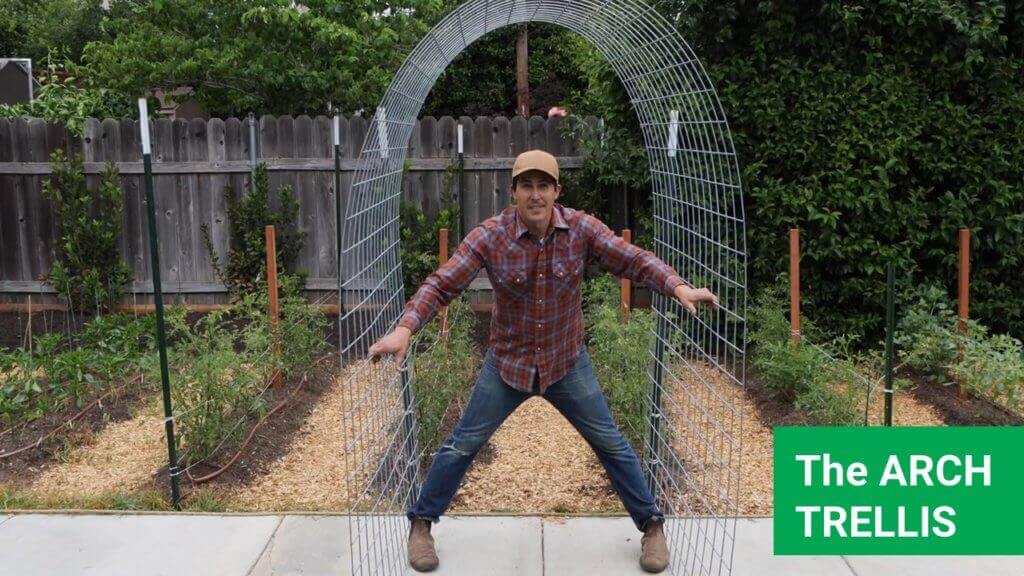
Just fix T-posts 3-4 feet apart in the ground and then wire the Cattle Panel along with the T-posts as shown in the picture below. It’s that simple!
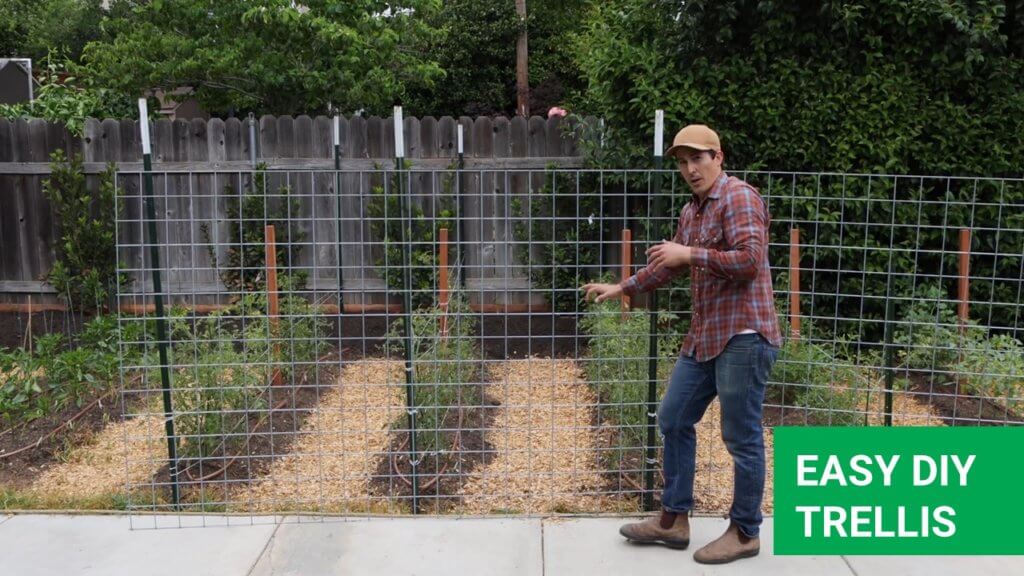
I hope that you getting a ton of information from this blog. Subscribe to our email newsletter so you don’t miss out on our upcoming articles.
You will have to buy the following materials for making a DIY Trellis for your greenhouse cucumbers, tomatoes and other veggies.
You will be needing galvanized cattle panels (Sheep fence) for building your DIY greenhouse trellis. These panels are 16 feet wide and 5 feet high.
In this tutorial, we will be building a DIY Greenhouse trellis which is 5 feet high and 8 feet long. Therefore, we will cut the Cattle Panles in half (as they are 16 feet long).
Usually, you can find Trellises that are 4-5 feet tall, but if you need 8-10 feet high trellis of height then you can vertically join two cattle panels together.
Remember, the height of your DIY greenhouse Trellis will depend on your choice and it also depends on the type of vegetables you want to grow. If you are growing tomatoes, I recommend your greenhouse trellis to be around 8 feet high and for cucumbers, I think 5-6 feet of height is enough.
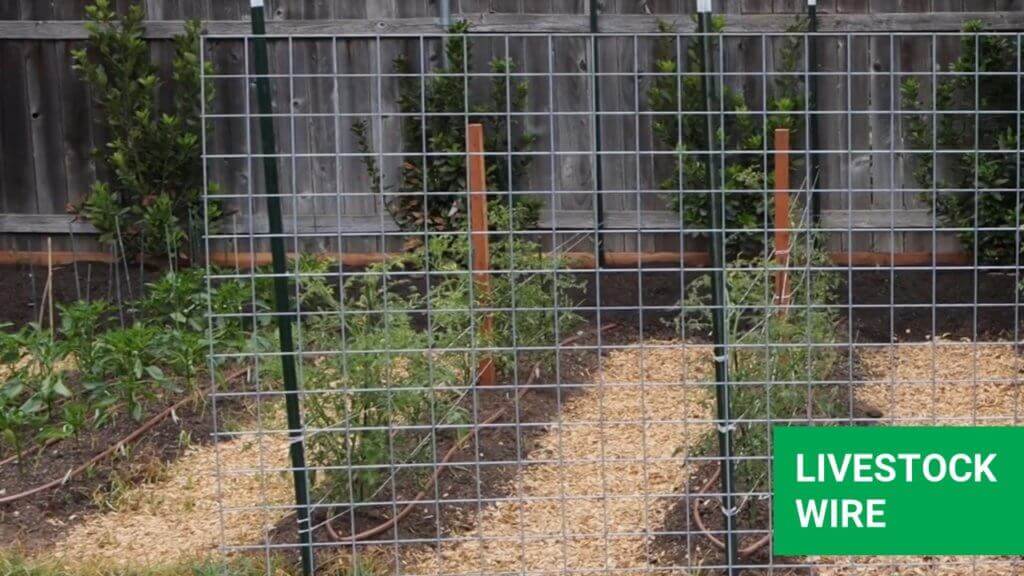
We will run these pipes along the edges of the cattle panel and they will strengthen the structure of the Trellis and will give your greenhouse trellis a clean and sturdy look.
The fence wire might bend because of the weight of different vegetables, especially at the center. Therefore, by using a ¾ pipe, it will ensure that the fence is thigh in place.
To make a single trellis we have 8 and 10 feet long ¾ inch conduit pipe with male threads on both ends. We will cut 10 feet long pipe into two pieces( 5 feet length for each). These 5 feet long pipes will be tied along the edges of the trellis.
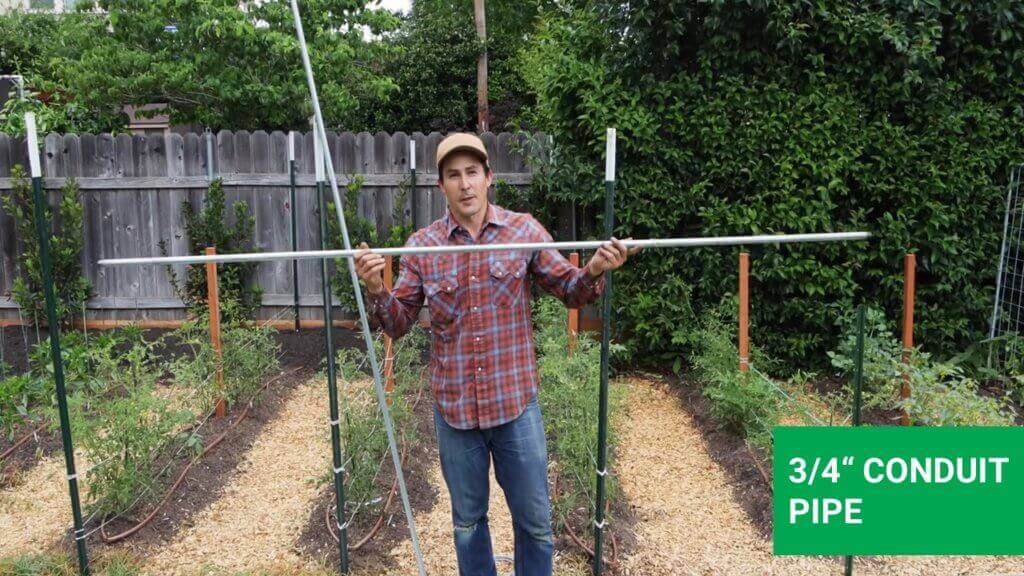
You will be needing ¾ inch elbows for connecting the side Pipes to the Pipe on the top.
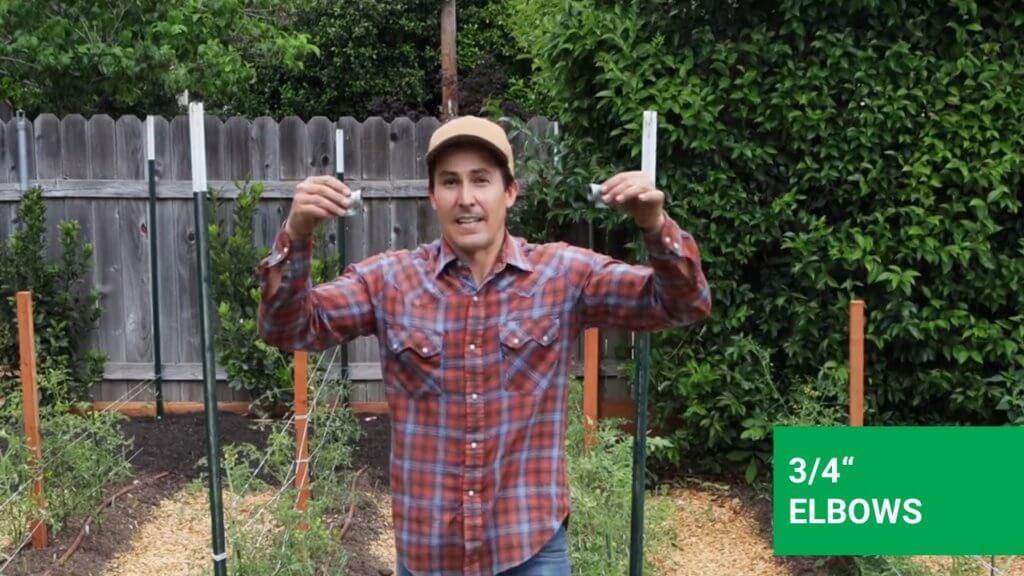
For installing a single Trellis panel, you will be using two 4 feet long rebars. You will have to hammer the rebar 2-2.5 inches deep into the ground so, it can support the trellis through the holes in the pipes.
Finally, We will be using Galvanized wire for attaching the cattle panel to the conduit pipes.
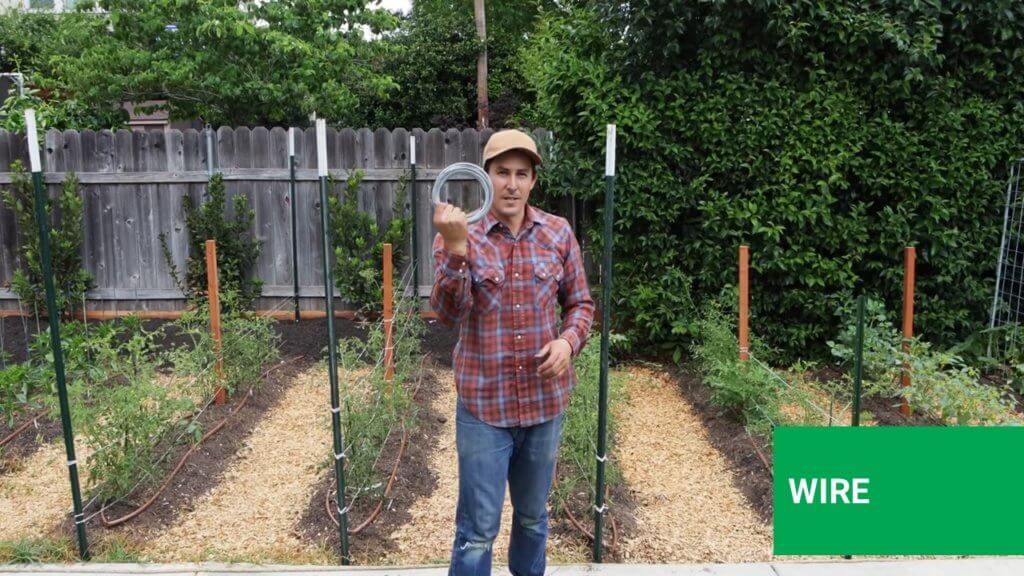
Let’s Get Started 🙂
Before, starting this tutorial I will give a shout out to Kyle for Urban Farmstead for his support in making this tutorial and for providing the necessary images for making this tutorial easy to understand.
First, You will have to examine the raised beds you have installed in your greenhouse. Depending upon the length of the raised beds of your greenhouse tomatoes and cucumbers you will have to cut the cattle panel to that specific length.
In our case, we are making 5 feet high and 10 feet long greenhouse trellis, whereas, the cattle panels that we are using are 16 feet in length and 5 feet in height.
So we are only cutting the Cattle Panels fence along the centre, to get two 5 by 8 feet pieces as shown in the Figure below.
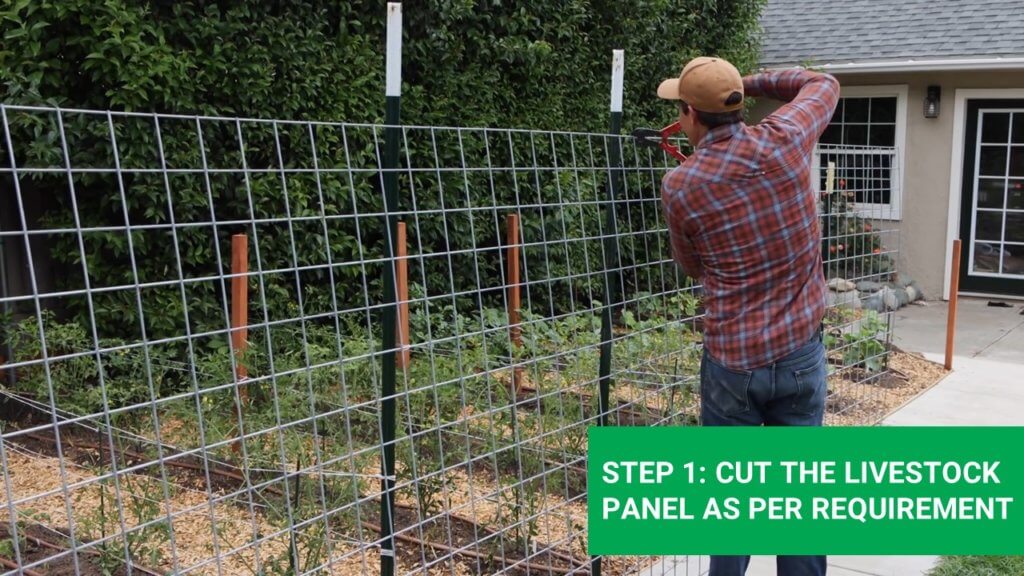
You can cut the cattle panel wire using a blot cutter as demonstrated in the Figure below.
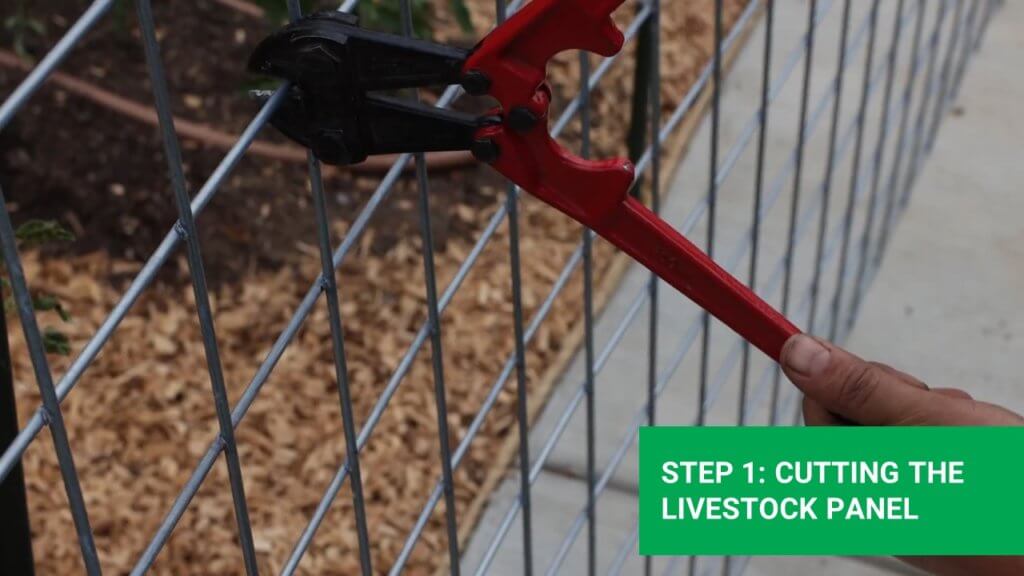
For this 5 x 8 feet DIY Greenhouse Trellis, we have used two conduit pipes. One pipe isv8 feet long and the other one is 10 feet long. Both of these conduit pipes have male threads on both of its ends.
The 8 feet long conduit pipe will be used along the length of the greenhouse trellis at top. Whereas we will have to cut the 10 feet long 3/4” conduit pipes into two 5” long pieces.
Mark a point at the centre of the conduit pipe as shown in the Figure given below.
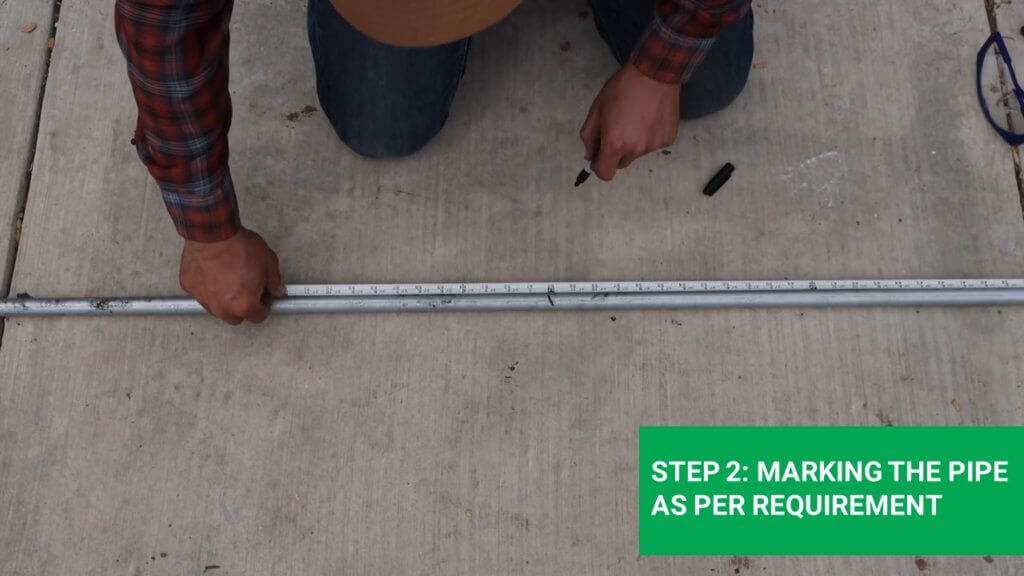
Cut the pipe at the marked position as shown in the Figure given below.

After you have cut the conduit pipes the next step in building your DIY greenhouse Trellis to tread the pieces together. For this reason, you will be using a galvanized elbow with female threads.
First thread the elbow to the 8 feet pipe as illustrated in the Figure give below.
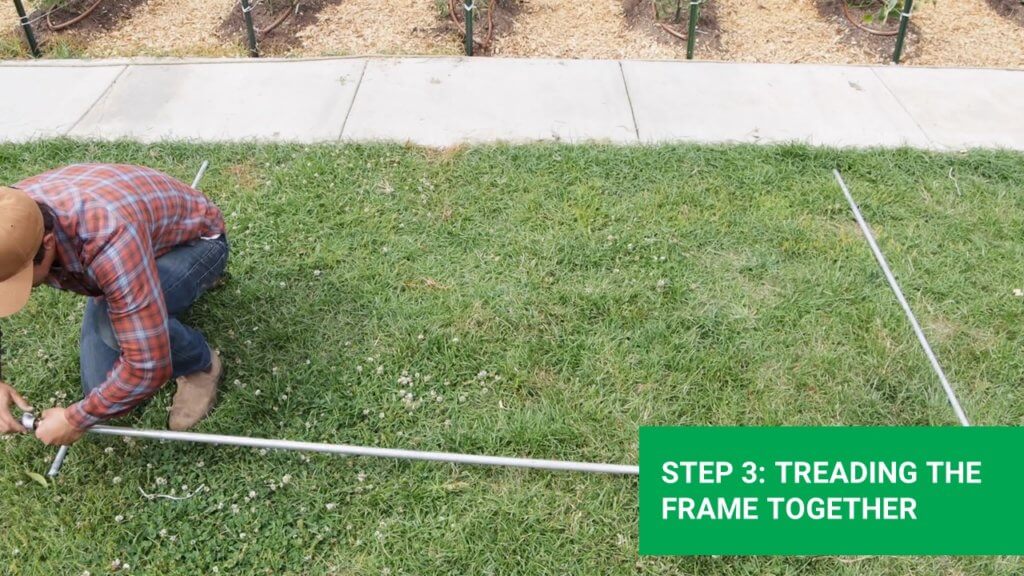
Then thread the 5 feet pipe to the elbow as illustrated below. You will have to do it for both ends.

The next step is to connect the Cattle Panels to the conduit frame. Lay the cattle panel on the ground and line up the conduit frame along with it.
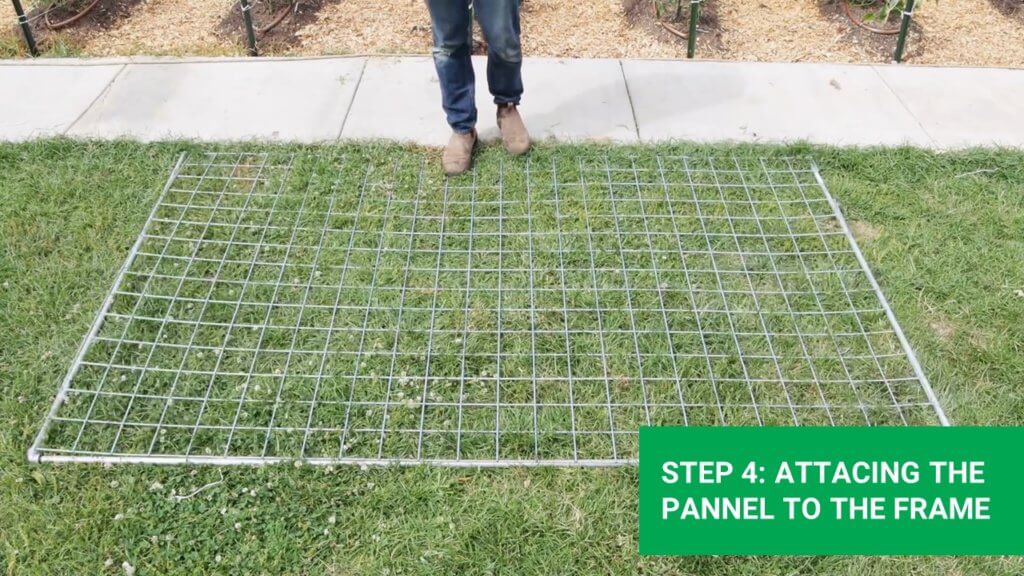
Then fasten the frame to the Cattle Panels using wire. It is best to tie the fence with the pipe after every 1-2 feet. After completion of this step, your DIY Greenhouse Trellis is ready.
Now the next step is to install the trellis onto your greenhouse raised beds.
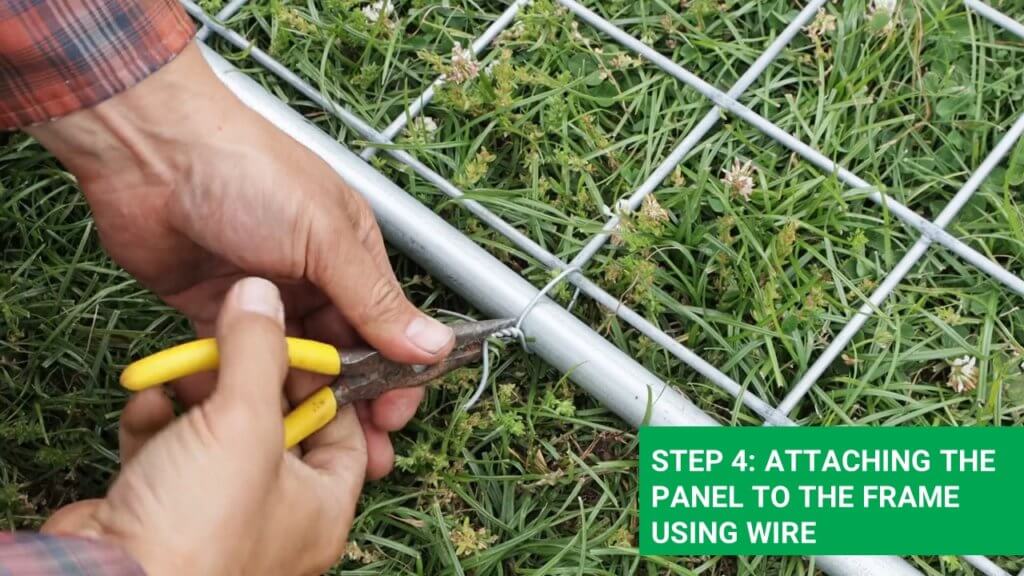
Take 4 feet long rebar and drive about 2 feet into the greenhouse raised bed. Make sure that the rebar is firm in place and will keep intact.
We have hammered 2 Rebars at a distance of 8 feet apart because our trellis is 8 feet in length.
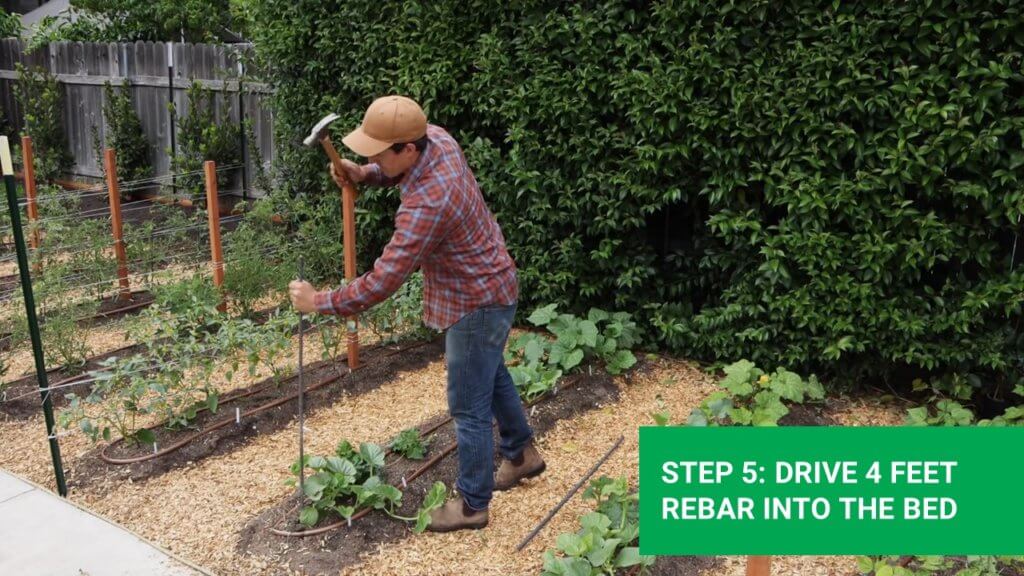
The final step is to slide the greenhouse trellis into the rebars. The rebars will hold the trellis and you can easily grow cucumbers, squash, tomatoes, and other vegetables.
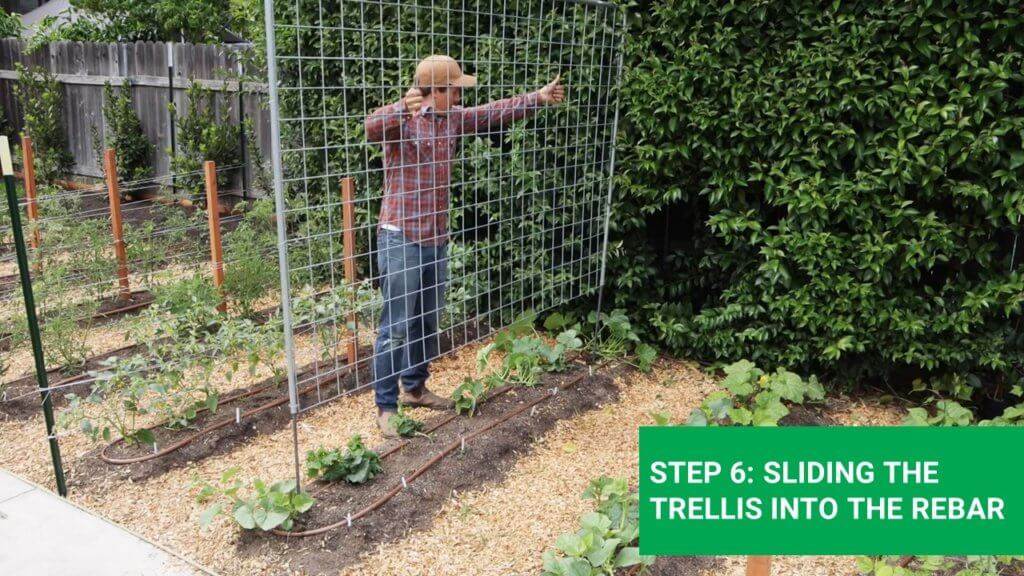
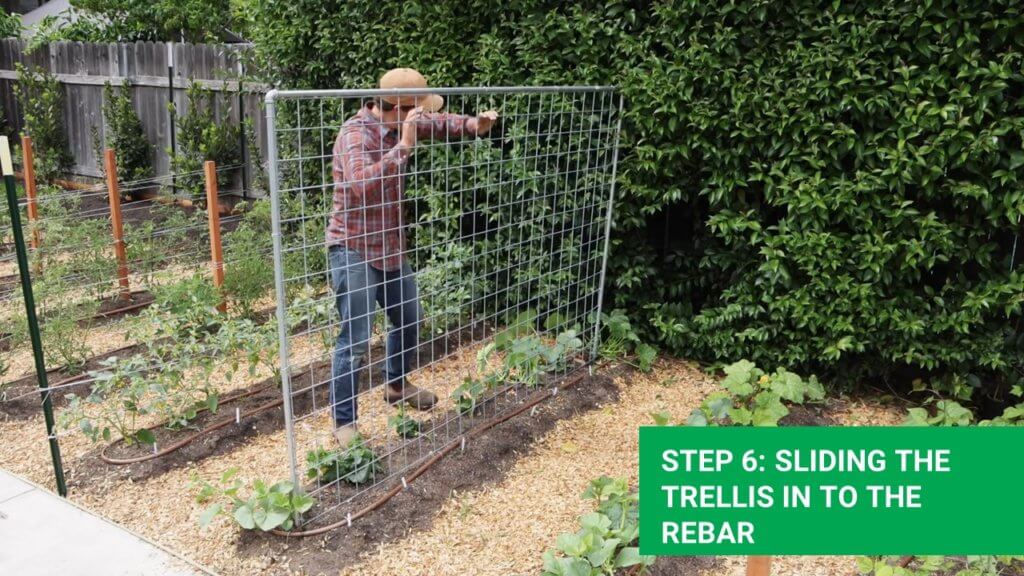
Congratulations! You have successfully build your greenhouse trellis capable of supporting cucumbers, tomatoes, and squash, melons, and other vegetables.
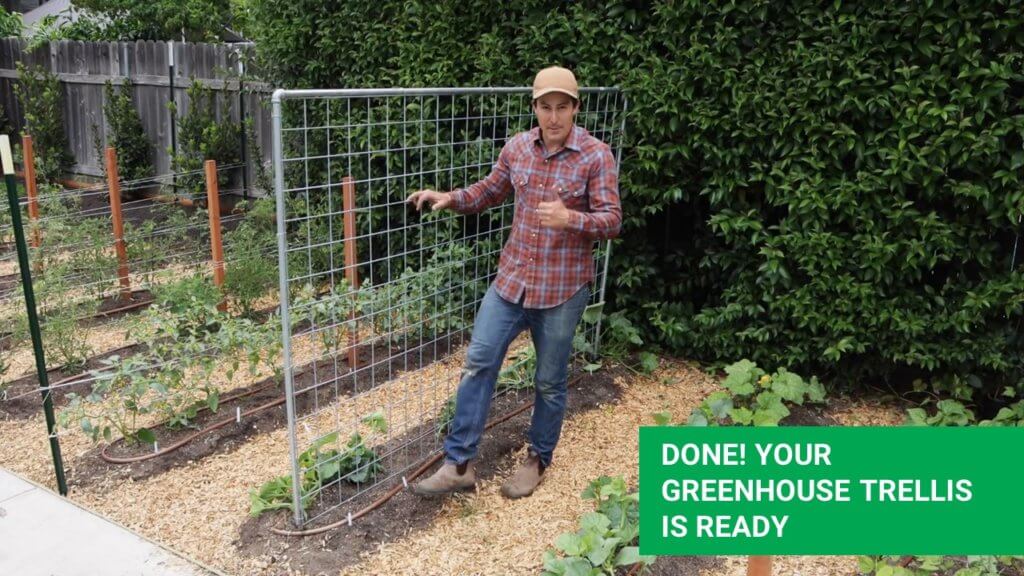
Hope this DIY tutorial was helpful, we have other cool DIY greenhouse projects for you. I will list there here.
You can also check out the video of this build, by Kyle from Urban homestead. (Thanks Kyle for recording this awesome video tutorial)
We hope that you now know how to build a cool and good looking DIY greenhouse Trellis. If you have any questions feel free to write it in the comments section below.
Share this Pin to your Pinterest “Greenhouse Growing” board. Happy Gardening!
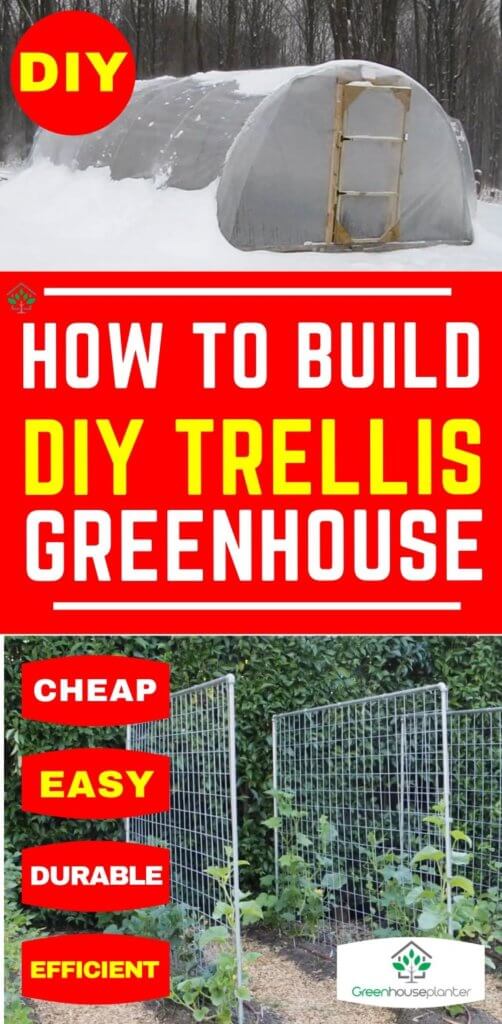
Comments are closed.
When you order the panels, ask for cattle panels and not hog panels. Hog panels are shorter and the openings are closer. They’ll still work if you want trellis that isn’t tall.
Thankyou, hope it will help our readers 🙂